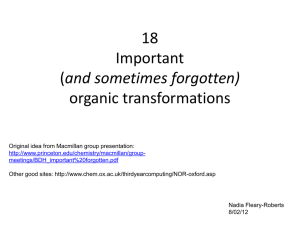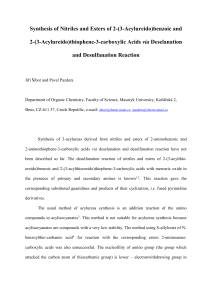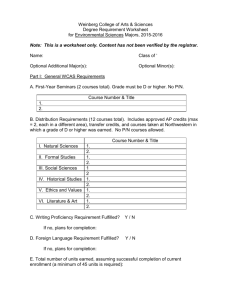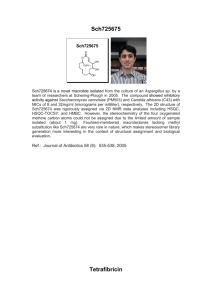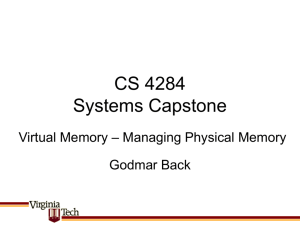Effect of an industrial chemical waste on the uptake
advertisement
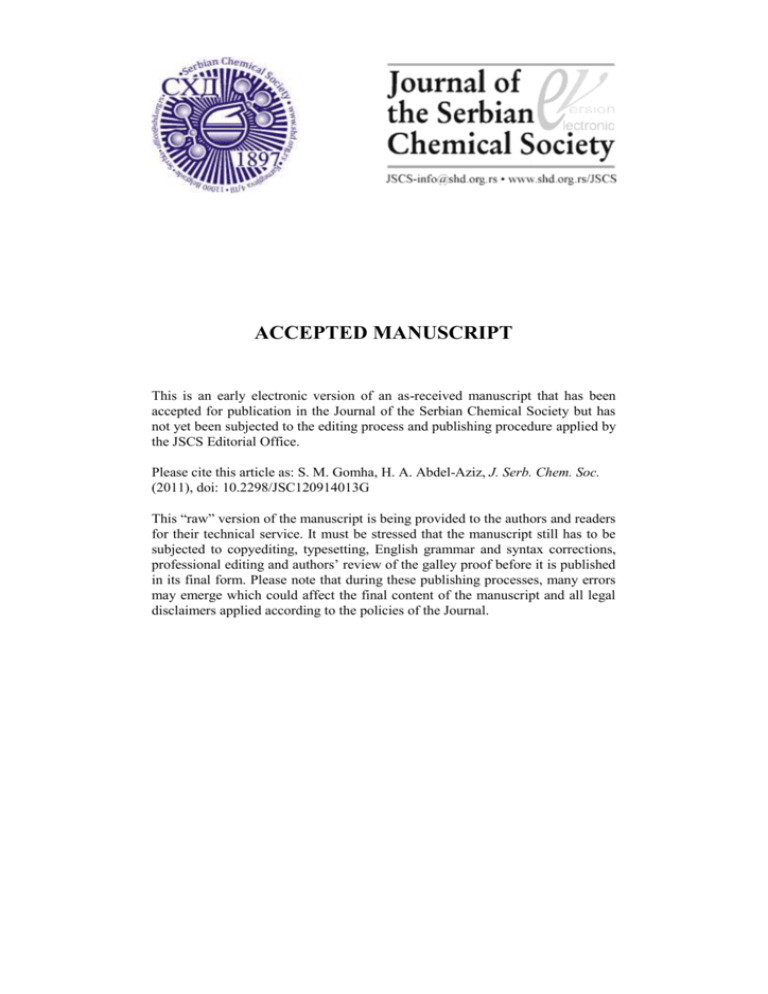
ACCEPTED MANUSCRIPT This is an early electronic version of an as-received manuscript that has been accepted for publication in the Journal of the Serbian Chemical Society but has not yet been subjected to the editing process and publishing procedure applied by the JSCS Editorial Office. Please cite this article as: S. M. Gomha, H. A. Abdel-Aziz, J. Serb. Chem. Soc. (2011), doi: 10.2298/JSC120914013G This “raw” version of the manuscript is being provided to the authors and readers for their technical service. It must be stressed that the manuscript still has to be subjected to copyediting, typesetting, English grammar and syntax corrections, professional editing and authors’ review of the galley proof before it is published in its final form. Please note that during these publishing processes, many errors may emerge which could affect the final content of the manuscript and all legal disclaimers applied according to the policies of the Journal. J. Serb. Chem. Soc. 78 (0) 1–9 (2013) JSCS–5483 UDC Original scientific paper 1 2 Synthesis of new functionalized derivatives of indolo[2,3-e][1,2,4]-triazolo-[4,5-b]-1,2,4-triazine 3 SOBHI M. GOMHA1* and HATEM A. ABDEL-AZIZ2 4 5 6 1Department 2Department of Chemistry, Faculty of Science, Cairo University, Giza, Egypt and of Pharmaceutical Chemistry, College of Pharmacy, King Saud University, P. O. Box 2457, Riyadh 11451, Saudi Arabia 7 (Received 14 September, revised 3 October 2012) 8 9 10 11 Abstract: New functionalized 1,2,4-triazolo-[4,3-b]-1,2,4-triazino-[5,6-b]indole derivatives were synthesized via reaction of the hydrazonoyl halides with 5H2,3-dihydro-1,2,4-triazino[5,6-b]indole-3-thione or its 3-methylthio derivative. The mechanism and the regioselectivity of the studied reactions are discussed. 12 13 Keywords: hydrazonoyl halides; 1,2,4-triazino[5,6-b]indole-3-thione; thiohydrazonates. 14 15 16 17 18 19 20 21 22 23 24 25 26 27 28 29 30 31 INTRODUCTION As a continuation of systematic studies of hydrazonoyl halides devoted to the various aspects of their chemistry,1–6 it was decided to investigate their use as precursors in the synthesis of the title compounds. In the present contribution, the synthesis is reported of a series of new functionalized derivatives of indolo[2,3e][1,2,4]-triazolo-[4,5-b]-1,2,4-triazine via the reaction of the respective hydrazonoyl halides 5 with either 5H-2,3-dihydro-1,2,4-triazino[5,6-b]indole-3thione 3 or its 3-methylthio derivative. The regiochemistry of the reactions studied and the antimicrobial activity of the products isolated from such reactions were investigated. The interest in synthesis of the target compounds is due to the fact that various derivatives of the 5H-1,2,4-triazino[5,6-b]indole derivatives have aroused considerable interest as a result of their broad spectrum of antibacterial, antifungal, antiparasitic activities and hypertensive properties.7–13 Considerable attention has been drawn to the synthesis of several condensed heterocyclic systems derived from triazoles and triazines.14–19 Furthermore, some triazolo1,2,4-triazino[5,6-b]indoles were reported to have medicinal applications, such as antiviral, antibacterial and antimalarial activities.20–23 * Corresponding author. E-mail: s.m.gomha@hotmail.com doi; 10.2298/JSC120914013G 1 2 GOMHA and ABDEL-AZIZ 32 RESULTS AND DISCUSSION 33 34 35 36 37 38 39 40 41 42 43 44 45 46 47 48 49 50 51 52 53 54 55 56 57 58 59 60 61 62 63 64 65 66 67 68 69 70 71 The starting 5H-2,3-dihydro-1,2,4-triazino[5,6-b]indole-3-thione 3 or its 3methylthio derivative 424 were prepared by literature methods (Scheme 1). Reaction of 3 or 4 with 5 was realized in chloroform in the presence of triethylamine under stirring at room temperature. In all cases, hydrogen sulfide was evolved during the course of the reaction and so stirring of the reaction mixture was continued until evolution of hydrogen sulfide ceased. Work up of the reaction mixture afforded, in each case, one isolable product as evidenced by TLC analysis of the crude product. Elemental analyses and IR, 1H- and 13CNMR spectroscopy, which showed all the expected signals (see the Supplementary material to this paper), confirmed the structures of the prepared compounds. The regioselectivity of the reaction of 3 with 5 seems consistent with literature reports, which indicated that N-4 is the site of preference for cyclization, the isolated products were assigned the structure indolo[2,3e][1,2,4]-triazolo-[4,5-b]-1,2,4-triazine derivatives 8 rather than the isomeric structure 9.25–27 The assignment of structure 8 was further evidenced by an alternate synthesis. Thus, treatment of 2-methylthio derivative 4 with each of the hydrazonoyl halides 5 in chloroform in the presence of triethylamine at room temperature resulted in the evolution of methanethiol and the formation of products that proved identical in all respects (IR, MS, m.p. and mixed m.p.) with 8 (Scheme 1). Formation of compounds 8 from the thione 3 and hydrazonoyl halides 5 could be accounted for by the hydrazonoylation of 3 to give the thiohydrazonate esters 6. This is followed by Smiles type rearrangement28 of the latter esters to form the respective thiohydrazides 6A, which in turn underwent cyclization to give 8 as the end products (Scheme 2). Under the employed reaction conditions, it seems that both intermediates 6 and 6A are consumed immediately after formation since all attempts to isolate them failed. The involvement of 6 and 6A as intermediates in the formation of 8 was evidenced by alternate synthesis of 8b, 8e and 8h (Scheme 2). Thus, treatment of 3 with each of 3-chloro-2,4-pentanedione, ethyl α-chloroacetoacetate and αchloroacetoacetanilide in ethanol in the presence of sodium ethoxide afforded the respective substituted products 11b, 11e and 11h. Coupling of each of the latter with benzenediazonium chloride in ethanol in the presence of sodium acetate yielded the thiohydrazonates 6b, 6e and 6h, respectively (Scheme 3) via Japp– Klingemann cleavage of the acetyl group.30 Treatment of the latter products 7 with sodium ethoxide in ethanol afforded the respective compounds 8b, 8e and 8h, which were identical in all respects with those obtained from the reactions of 3 with each of 10b, 10e and 10h, respectively. These findings indicate that 6 and Synthesis of new triazolo-triazines 3 72 73 6A are intermediates in the studied reactions of 3 with 10 and that they are consumed as soon as they are formed under the employed reaction conditions. 74 75 76 77 78 79 80 81 82 83 84 85 86 87 88 89 90 91 92 93 94 95 96 97 98 99 100 101 102 103 104 105 106 107 108 109 110 111 112 113 114 115 EXPERIMENTAL Melting points were determined on a Gallenkamp apparatus and are uncorrected. The IR spectra were recorded in potassium bromide using a Pye-Unicam SP300 spectrophotometer. The 1H- and 13C-NMR spectra were recorded in DMSO-d6 using a Varian Gemini 300 NMR spectrometer (300 MHz for 1H-NMR and 75 MHz for 13C-NMR) and the chemical shifts were related to that of the solvent DMSO-d6. The mass spectra were recorded on GCMS-Q1000EX Shimadzu and GCMS 5988-A HP spectrometers, the ionizing voltage was 70 eV. Elemental analyses of the products were performed at the Microanalytical Centre of Cairo University, Giza, Egypt. 5H-2,3-Dihydro-1,2,4-triazino[5,6-b]indole-3-thione 3 and its 3methylthio derivative 424 and the hydrazonoyl halides 529–35 were prepared as described in the literature. General procedure for the synthesis of indolo[2,3-e][1,2,4]-triazolo-[4,5-b]-1,2,4-triazine derivatives (8a–m) Method A: To a mixture of 5H-2,3-dihydro-1,2,4-triazino[5,6-b]indole-3-thione 3 (2.02 g, 0.01 mol) and an appropriate hydrazonoyl halide (5) (0.01 mol) in chloroform (40 mL), triethylamine (1.4 mL, 0.01 mol) was added. The reaction mixture was stirred at room temperature until cessation of H2S evolution (4–6 h). The solvent was evaporated and the residue was treated with an ice/ HCl mixture. The solid product was collected, washed with water and crystallized from the appropriate solvent to give the respective derivatives 8. Method B: To a solution of 2-methylthio pyrido[2,3-d]pyrimidine (4) (3.9 g, 0.01 mol) in chloroform (30 mL) containing triethylamine (1.4 mL, 0.01 mol), the appropriate hydrazonoyl halide (5) was added (0.01 mol) and the resulting solution was stirred at room temperature overnight. The product was collected, washed with water and crystallized from an appropriate solvent to give the respective products 8, which are identical in all respects (m.p., mixed m.p. and IR) to those prepared by method A. Method C: To a stirred ethanolic sodium ethoxide solution, prepared from Na metal (0.23 g, 10 mg atom) and absolute ethanol (20 mL), was added each of the compound 6b, 6e and 6h (10 mmol) and the reaction mixture was stirred at room temperature for 12 h, during which time, the starting reactants 6 dissolved and the crude products precipitated. The latter was filtered, washed with H2O, dried and finally crystallized from the appropriate solvent to give products, identified as 8b, 8e and 8h, respectively. The latter products proved to be identical in all respects (m.p., mixed m.p. and IR) with those obtained from 3 and the respective hydrazonoyl halides 5. Synthesis of the thiohydrazonates (6) To a solution of each of 11b, 11e and 11h (10 mmol) in ethanol (40 mL) was added sodium acetate trihydrate (1.38 g, 10 mmol) and the mixture was cooled to 0–5 °C in an ice bath. To the resulting cold solution was added portionwise a cold solution of benzenediazonium chloride, prepared by diazotizing aniline (10 mmol) dissolved in 6 mL HCl (6 M) with a solution of sodium nitrite (0.7 g, 10 mmol) in 10 cm 3 H2O. After complete addition of the diazonium salt, the reaction mixture was stirred for a further 12 h at room temperature. The solid precipitate was filtered off, washed with water, dried and crystallized from the appropriate solvent to give the respective pure 6b, 6e and 6h. 4 GOMHA and ABDEL-AZIZ 116 117 118 119 120 121 122 Reactions of 3 with active chloromethylene compounds To a solution of 3 (2.02 g, 0.01 mol) in chloroform was added triethylamine (1.4 mL, 0.01 mol) and the mixture was stirred for 10 min at room temperature. To the resulting clear solution was added an active chloromethylene compounds (0.01mol) drop-wise under stirring. After complete addition, the reaction mixture was stirred for further 24 h at room temperature. The solid that precipitated was filtered off, washed with H 2O, dried and finally crystallized from the appropriate solvent to give pure 11b, 11e and 11h. 123 CONCLUSION 124 125 126 127 In summary, the reactivity of 5H-2,3-dihydro-1,2,4-triazino[5,6-b]indole-3thione or its 3-methylthio derivative is a versatile and readily accessible building block for the synthesis of new 1,2,4-triazolo-[4,3-b]-1,2,4-triazino-[5,6-b]indole derivatives. 128 129 130 131 132 133 134 135 136 137 138 139 140 141 142 143 144 145 146 147 148 149 150 151 152 153 154 155 156 157 158 ИЗВОД СИНТЕЗА НОВИХ ФУНКЦИОНАЛИЗОВАНИХ ДЕРИВАТА ИНДОЛО[2,3-e][1,2,4]-ТРИАЗОЛО-[4,5-b]-1,2,4-ТРИАЗИНА SOBHI M. GOMHA1 и HATEM. A. ABDEL-AZIZ2 1Department of Chemistry, Faculty of Science, Cairo University, Giza, Egypt и 2Department of Pharmaceutical Chemistry, College of Pharmacy, King Saud University, P.O. Box 2457, Riyadh 11451, Saudi Arabia Нови функционализовани деривати 1,2,4-триазоло-[4,3-b]-1,2,4-триазино-[5,6-b]индола синтетисани су реакцијом хидразоноил-халогенида и 5H-2,3-дихидро-1,2,4-триазино[5,6b]индол-3-тиона или одговарајућег 3-метилтио деривата. У раду су разматрани механизам и региоселективност испитиваних реакција. (Примљено 14. септембра, ревидирано 3. октобра 2012) 1. 2. 3. 4. 5. 6. 7. 8. 9. 10. 11. 12. 13. REFERENCES A. S. Shawali, S. M. Gomha, J. Pract. Chem. 342 (2000) 599 S. M. Gomha, Monatsh. Chem. 140 (2009) 213 I. M. Abbas, S. M. Riyadh, M. A. Abdallah, S. M. Gomha, J. Heterocycl. Chem. 43 (2006) 935 A. S. Shawali, S. M. Gomha, Tetrahedron 58 (2002) 8559 S. M. Gomha, H. M. E. Hassaneen, Molecules 16 (2011) 6549 S. M. Gomha, S. M. Riyadh, ARKIVOC xi (2009)58 V. J. Ram, Arch. Pharm. 313 (1980) 108 J. M. Gwaltney, Proc. Soc. Exp. Biol. Med. 133 (1970) 1148 J. M. Z. Gladych, R. Hornby, J. Hunt, D. Jack, J. J. Boyle, R. J. Ferlauto, R. Haff, C. Kormendy, F. Stanfield, R. Stewart, J. Med. Chem. 15 (1972) 277 R. F. Haff, J. J. Boyle, R. Stewart, R. Ferlando, J. M. Z. Gladych, J. Hunt, D. Jack, Nature 221 (1969) 286 J. M. Z. Gladych, R. Hornby, J. H. Hunt, D. Jack, J. J. Boyle, R. J. Ferlauto, R. F. Haff, C. G. Kormendy, F. J. Stanfield, R. C. Stewart, J. Med. Chem. 15 (1972) 277 R. F. Haff, J. J. Boyle, R. Stewart, R. Ferlando, J. M. Z. Gladych, J. Hunt, D. Jack, Nature 221 (1969) 286 J. M. Gwaltney, Proc. Soc. Exp. Biol. Med. 133 (1970) 1148 Synthesis of new triazolo-triazines 159 160 161 162 163 164 165 166 167 168 169 170 171 172 173 174 175 176 177 178 179 180 181 182 183 184 185 186 14. 15. 16. 17. 18. 19. 20. 21. 22. 23. 24. 25. 26. 27. 28. 29. 30. 31. 32. 33. 34. 35. 5 R. Mardronero, S. Vega, J. Heterocycl. Chem. 15 (1978) 1127 S. W. Schneller, D. G. Barthdomew, J. Heterocycl. Chem. 15 (1978) 439 E. J. Gray, M. F. G. Stevens, J. Chem. Soc., Perkin Trans. 1 (1977) 1492 M. Robba, D. Maume, J. C. Lancelot, J. Heterocycl. Chem. 15 (1978) 1209 K. C. Joshi, A. Dandi, S. Baweia, J. Indian Chem. Soc. 66 (1989) 690 M. I. Younes, H. H. Abbas, S. A. Metwally, Arch. Pharm. (Weinheim) 320 (1987) 1191 A. Dorn, S. R. Vippagunta, H. Matile, C. Jaquet, J. L. Vennerstrom, R. G. Ridley, Biochem. Pharmacol. 55 (1998) 727 T. J. Egan, D. C. Ross, P. A. Adams, Afr. J. Sci. 92 (1996) 11 C. D. Fitch, R. Chevli, H. S. Banyal, G. Phillips, M. A. Pfaller, D. J. Krogstad, Antimicrob. Agents Chemother. 21(1982) 819 P. A. Adams, P. A. M. Berman, T. J. Egan, P. J. Marsh, J. J. Silver, Inorg. Biochem. 63 (1996) 69 Jag Mohan, Anjaneyulu G S R & Kiran, Indian J. Chem., Sect. B 27 (1988) 346 V. J. Ram, V. Dube, A. Vlietinck, J. Heterocycl. Chem. 24 (1987) 1435 F. F. Abdel-Latif, R. M. Shaker, M. Mahgoub, Z. A. A. Bader, J. Heterocyl. Chem. 26 (1989) 769 E. S. H. El Ashry, N. Rashed, H. Abdel-Hamid, E. S. Ramadan, Z. Naturforsch., B: Chem. Sci. 52 (1997) 873 K. Ishii, M. Hatanaka, I. Ueda, Chem. Pharm. Bull. 39 (1991) 3331 P. Wolkoff, Can. J. Chem. 53 (1975) 1333 A. S. Shawali, A. O. Abdelhamid Bull. Chem. Soc. Jpn. 49 (1976) 321 C. Bullow, E. King, Liebigs Ann. 439 (1924) 211 G. Favrel, Bull. Soc. Chim. Fr. 31 (1904) 150 W. Dieckmann, O. Platz, Ber. Dtsch. Chem. Ges. 38 (1906) 2989 H. M. Hassaneen, A. S. Shawali, N. M. Abunada, Org. Prep. Proced. Int. 24 (1992) 171 T. Curtius, J. Prakt. Chem. 51 (1899) 168 6 GOMHA and ABDEL-AZIZ NNHCSNH 2 O NH2 NHCSNH 2 O 1 O AcOH N H 2 N H N NH N N SMe MeI / NaOH N N N H 3 N 4 H 187 KOH Scheme 1 S 7 Synthesis of new triazolo-triazines N X N SR N N H 3, R = H; 4, R = Me + R' NNHAr 5a-j, X = Cl 5k-m, X = Br R=H R = Me R' NNHAr R' N NH N N N R' / Z (Ar = ZC6H4 ) Ph / H COMe / H COMe / 4-CH3 COMe / 4-Cl COOEt / H COOEt / 4-CH3 COOEt / 4-Cl CONHPh / H CONHPh / 4-CH3 CONHPh / 4-Cl COPh / H COPh / 4-CH3 COPh / 4-Cl N N 6 7 R' 7A N N N N N H R' N HS N N Ar S 6A - MeSH R' N N Ar N N NH N N N N Ar N SMe H N -H2S N N N 6B 8a-m 188 189 NNHAr S SMe N 8 a b c d e f g h i j k l m Scheme 2 R' N N NH N Ar N N R' 9 Ar N N



